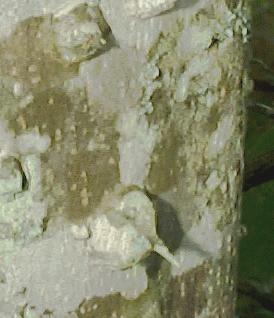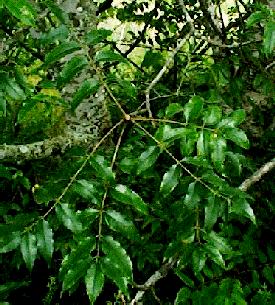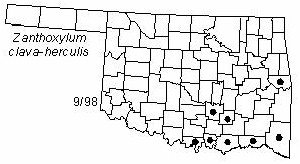

Small tree to 10 m (30 ft) tall and 15 cm (6 in) in diameter. Bark light gray, smooth, thin, with large thick spines partially enclosed by corky warts. Twigs thick, brown, hairy when young, with short thick spines often in pairs. Leaves pinnately compound, 15-25 cm (6-10 in) long. Leaflets 7-17, paired except at end, often with small paired spines at base, narrowly ovate, 4-7.5 cm (1.6-3 in) long, undulate margined, shiny dark green above, paler below. Flowers small, greenish-white, numerous in large cymes at ends of leafy twigs in early Spring. Fruits numerous small follicles, maturing in early Summer. Seeds shiny-black.
Distribution: The species is native to the Coastal Plain as far north as Virginia and southern Oklahoma.
Habitat: understory of moist forests, fencerows.
Comment: Called "toothache tree" because chewing the bark or leaves produces numbness in the mouth and tongue and reduces the pain of toothache. In Love and Marshall counties, where the ranges of Z. clava-herculis and Z. hirsutum overlap, numerous plants are found which are intermediate between the species. These intermediates are assumed to be hybrids. Hercules' club is sometimes planted as an ornamental, which may explain the disjunct populations in Coal, Pontotoc, and Sequoyah counties. Zanthoxylum is a Greek word meaning "yellow wood"; clava-herculis means "club of Hercules".
NWI status: FAC-
Distribution in Oklahoma: 
BACK
NEXT
RETURN TO INDEX
Last update: 9/23/99
 Go to Oklahoma Biological Survey Home Page
Go to Oklahoma Biological Survey Home Page
 Disclaimer
Disclaimer